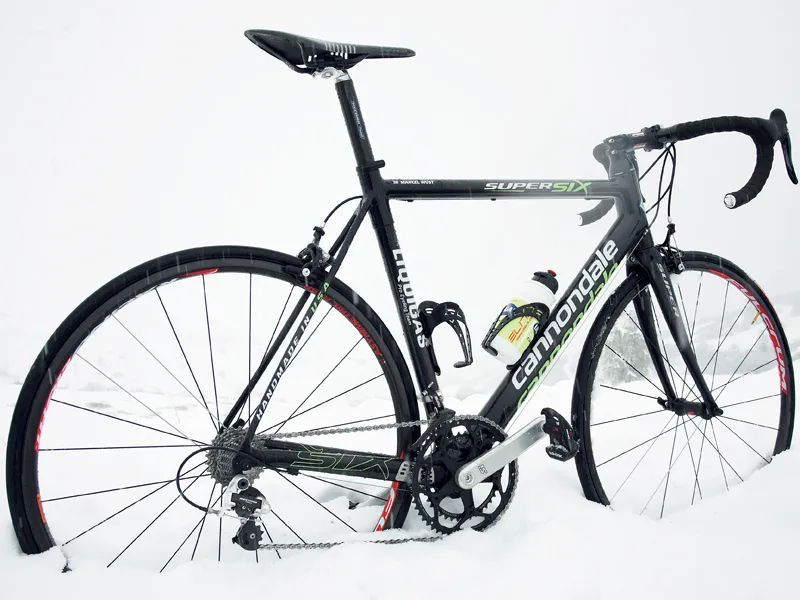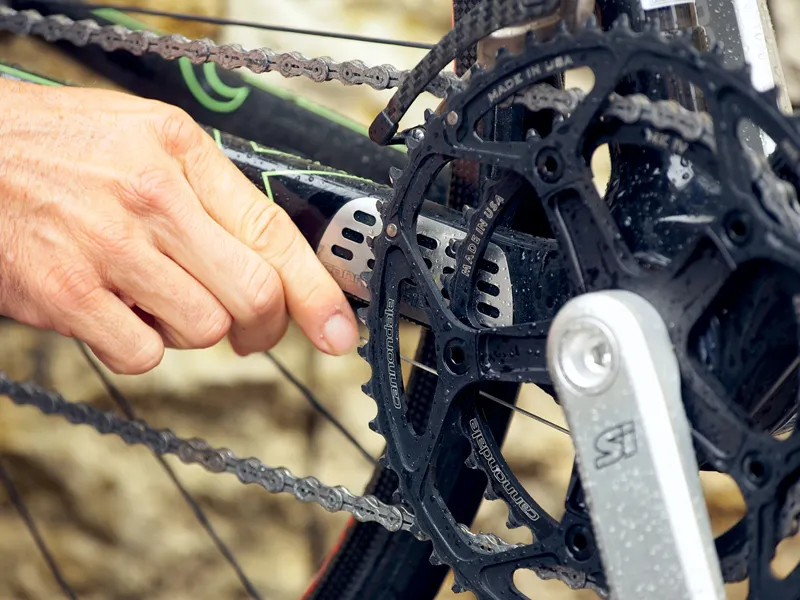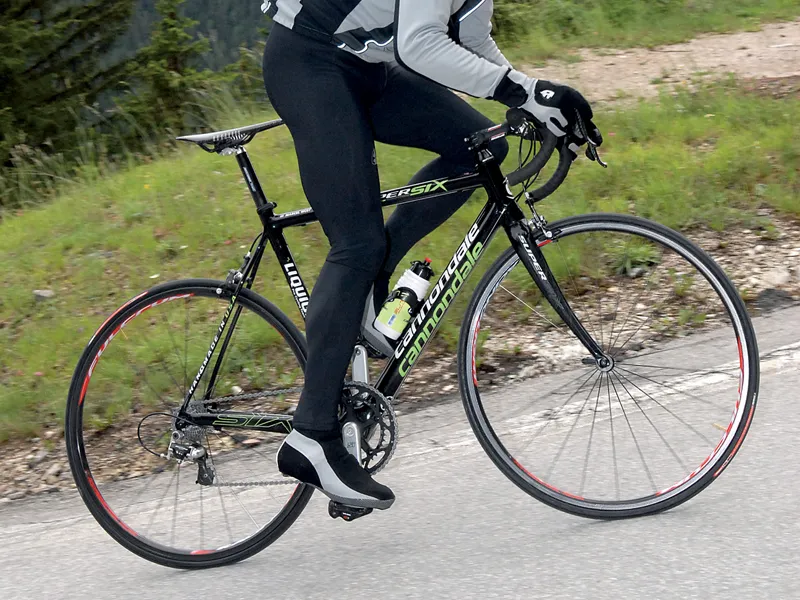>Usually, I'm not one to let a bit of inclement weather stand in the way of a good blast on a bike. But then, usually, when I leave my hometown of Cologne, in Germany, and head abroad to do a bike test, it involves bright sunshine. When I headed to the launch of Cannondale's new SuperSix in the Italian village of Arabba, at the bottom of the Passo Pordoi in the Dolomites, the blue skies I was expecting were in fact black. Although these weren't exactly ideal conditions for a bike test, I was in Arabba for one reason only - to see what the SuperSix had to offer - and, one way or another, that's what I was going to do.
>I took the opportunity afforded by the heavy rain to get to know the SuperSix theoretically. Cannondale had staff from just about every stage of the bike's manufacturing process - from planning to production - on hand to help with this. They produce their own tubes using a co-moulding process that gives minimal material overlap on the SuperSix's major tubes, thus shaving a few extra grams off the bike's weight. The American company take care of final bonding on home soil, too - a rarity these days - and their in-house test centre means they can monitor the quality of the final product and ensure clients receive the best bike possible.
>In theory, my size 56 frame should have weighed 1,050 grams. I didn't have any weighing scales on hand to confirm this, but lifting the SuperSix up manually made it clear that it might struggle to make the International Cycling Union's minimum competition weight of 6.8kg. This fact made me all the keener to get the SuperSix out into the mountains, but the weather still had other ideas.
>These days a woven carbon finish is commonplace, but you won't find one on the SuperSix. A solid black frame and matching componentry give the bike a strong visual impact, and one that's quite distinct. The Campagnolo Record groupset, Fulcrum Racing Light carbon wheels, Fizik Arione K1 saddle, FSA K-Force RK bar, FSA OS-99 stem and Record seatpost not only complement the overall look of the bike, but live up to the frame's high performance standards, too.
>The SuperSix's oversized bottom bracket and chainstays are manufactured as one unit, which means that you don't get the extra material, thinner walls and weaker construction that you would with overlapping joints. The saving in material means that you save on weight too. The thin (12mm) hourglass seatstays looked a little incongruous with the frame's fat tubes, but perhaps Cannondale are more concerned with low weight, stiffness and response than the aesthetic design of the bike here.
>With the worst of the downpour over, the time had come to get intimate with the SuperSix. Arabba lies at an altitude of 1602 metres and my test ride started on a downhill. A gusting wind dried the roads out quickly enough for me to let the SuperSix go in the first series of corners. And go it did...
>Rarely do I find a bike whose handling I love instantly, but that was certainly the case here. Thanks to the dependable Vittoria Open Corsa Evo CX tyres, I could lean right into the long, high-speed corners, and the obedient SuperSix was more than happy to follow the line I steered into. This, coupled with the bike's race-like geometry, made cornering a blast. I found the ride almost comfortable thanks to the bike's shock dampening, but this was countered by the chainstay's lateral stiffness, which ensured no power was wasted in flex.
>Cannondale's Si crank had already impressed me back in 2003 when the Six 13 was launched. The new version that comes with the SuperSix, weighing just 580 grams, is even more impressive. Lighter and stiffer than anything else currently on the market, these cranks also ensure that none of your energy is wasted. Out on the road, this "energy efficiency" wasn't tangible, but Cannondale's extensive testing while developing the Si and its ceramic bearings is sure to have paid off.
>
The rain decided to make a comeback for the first climb of the day; my muscles hardened up and cold water spayed up my back. I put a bit more effort into the ride to stave off the cold and it quickly became apparent how easy it was to get the SuperSix going. Had my muscles been up to the task, I'm sure the SuperSix could have handled a lot more pedal pressure.
>At the top of the five-kilometre climb I succumbed to the weather and put my rain jacket on as I was going along. The bike handled my "no-hands" riding perfectly, even when battered by a side wind. NOW SUITABLY protected from the elements, another downhill section beckoned. What I experienced next was no surprise: as with all carbon rims, the Fulcrum wheels didn't brake well in the wet. Even the carbon wheel-specific Campagnolo brake pads had little impact on the poor performance.
Unfortunately, the weather didn't afford me the opportunity to give the wheels a fair go in dry conditions. The Vittoria tyres, however, proved that they are great performers in all conditions.
>After a rather cold descent, I gave it everything I'd got on the 15-kilometre climb back to Arabba. The SuperSix handled the pressure easily and proved itself a top performer. It accelerated effortlessly out of the hairpin bends and the low rotating mass of its carbon wheels gave the impression that none of my energy was wasted.
>The Fulcrums proved to be stiff enough for this type of ride, but for a heavier sprinter, a sturdier choice of wheel might be advisable. This weight limitation only applies to the wheels, however; despite its light weight, the SuperSix frame can handle just about any weight of rider. It comes with a lifetime warranty for the first owner, too - a service rarely offered currently in the bike industry.
>This first-ever full carbon Cannondale is pretty much just that - right down to the front and rear drop-outs. The touches of aluminium found on the bike have been used only where strictly necessary. The drop-outs feature a one-millimetre aluminium plate for the rear left, and a one-millimetre aluminium hanger for the right to prevent excessive rubbing when changing wheels regularly. On the inside of the small chainring there is another aluminium plate that protects the right chainstay in case the chain gets dropped. The high modulus carbon of the bike is very fragile when it comes to impact, so the few extra grams added to the frame's overall weight by the aluminium components is weight wisely conceded.
Fof the final three kilometres of my ride back to the hotel, I shifted down a few gears, took the pressure of the pedals and coasted in calmly, mindful that my plan for the following day was to tackle the Passo Pordoi no matter what. The following morning I eagerly threw back the curtains to see... snowflakes. I made it out onto the Pordoi nonetheless, but I was glad not to be racing stage 15 of the Giro that had passed nearby just days before.
>The ride confirmed my previous day's impressions of the SuperSix. The geometry was well balanced - nervous enough to tackle the corners quickly, but also safely. The bike's components had been carefully chosen. Particularly impressive were the FSA bar/ stem combination and the state-of-the-art Fizik Arione saddle. All-carbon with a gel pad, the saddle was comfy and light. It's priced accordingly too, so if you want one you'd better raid your piggybank.
>The rear of the bike felt very stiff, and overall the bike gave good feedback from the road. As I steered around wet corners on the cold descent, the harmony between the fork and the headtube became apparent. Both are tapered (the headset from 1.18'' to 1.5'') and the fork comes with curved blades to suck up some of the road's roughness without creating a "dead" feel.
>In terms of weather, this has to rate as one of my worst bike tests ever. Thankfully, the same cannot be said of the new SuperSix, whose performance more than made up for the miserable day. As I prepared to leave the following day, the Dolomites were still covered in snow, but this time a clear blue sky provided their backdrop.
>I'd have gladly swapped my rental car for the SuperSix for the ride to the airport!
In its combination of power transfer, stiffness, comfort and handling, the SuperSix is Cannondale's best offering to date. It's a pure racing machine and the more you push it, the more you'll get from it. The Team Liquigas model comes with a Campag groupset, but other models come with Shimano Dura-Ace or Ultegra and a compact chainring too - so you should find something to suit you. It's got a hefty price tag, but there's no doubt that with the SuperSix you get bang for your buck.


